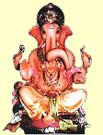|
|
| Ganesh Chaturthi celebrates the birth of Lord
Ganesha. Ganesha, the elephant-headed god, is the son of Lord Shiva
and Goddess Parvati. The following story in Hindu mythology explains
the birth of Ganesha. Once Parvati was alone in her house. She wanted
to take a bath but there was no one in the house to watch for visitors.
Parvati created young Ganesha from the dust of her own body and
placed him at the entrance of the house, with instructions not to
allow anyone inside until she finished her bath. |
 |
During this time Shiva returned, but was prevented by Ganesha from entering
the house. Shiva was enraged for being denied entrance to his own house
and he cut off Ganesha's head in anger. When Parvati learned of this tragedy,
she appealed to Shiva for mercy. Shiva ordered his servants to go out
and bring the head of the first creature they saw. The servant's eyes
laid upon an elephant. They cut the elephant's head and brought it before
Shiva. Shiva used the elephant-head to bring Ganesha back to life, thus
giving birth to the elephant-head's god. Shiva also pro-nounced Ganesha
the god of wisdom and prosperity.
The Ganesh Chaturthi festival lasts for one week. During this festival
the devotees offer prayers, perform dances, and worship Ganesha in homes
and temples. On the last day, clay models of Ganesha are carried through
a procession for immersion into water at a sea, river or lake. Ganesh
Chaturthi is a very popular festival in Maharashtra, where huge clay models
of Ganesha are carried on floats in a procession that is marked by singing,
playing of drums, blowing of conches (huge seashells), and the striking
of cymbals. The procession ends at a seashore, river or a lake, where
Ganesha is immersed into the water.
A large body of water (sea, river or lake) symbolizes the impersonal aspect
of Brahman, the sole essence of the universe. An icon of deity (god or
goddess) represents the personal aspect of Brahman. Thus immersing clay
models of Ganesha in water indicates that in ultimate analysis the personal
and impersonal aspects of Brahman are one's own spiritual experience.
©
2001 Vandemataram.com All rights reserved.
|
 |